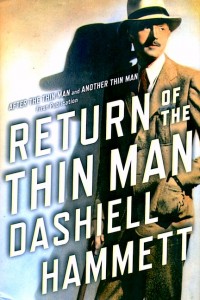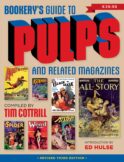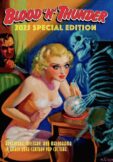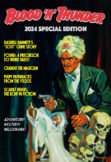EDitorial Comments
This Year’s Two Top Stocking Stuffers (Provided You Have Big Stockings)
Christmas came a little early this year, and I’m delighted to see that jolly old St. Nick hasn’t lost his touch: He still knows the type of present this good little boy likes to find under the tree. And I suspect most of you will feel the same way about these particular gifts. . . .
 The Big Book of Ghost Stories is Otto Penzler’s latest anthology, and a worthy successor to his Big Book of Pulps, Big Book of Black Mask Stories, and Big Book of Adventure Stories. This jumbo trade paperback reprints nearly 80 yarns in more than 800 pages, and while some are overly familiar (W. W. Jacobs’ “The Monkey’s Paw” immediately comes to mind), many are lesser-known works culled from the pages of pulp magazines. Weird Tales and Ghost Stories are quite well represented, and Otto has pulled additional spine-tinglers from Unknown and Dime Mystery as well.
The Big Book of Ghost Stories is Otto Penzler’s latest anthology, and a worthy successor to his Big Book of Pulps, Big Book of Black Mask Stories, and Big Book of Adventure Stories. This jumbo trade paperback reprints nearly 80 yarns in more than 800 pages, and while some are overly familiar (W. W. Jacobs’ “The Monkey’s Paw” immediately comes to mind), many are lesser-known works culled from the pages of pulp magazines. Weird Tales and Ghost Stories are quite well represented, and Otto has pulled additional spine-tinglers from Unknown and Dime Mystery as well.
In his introduction Otto describes facing a “confounding challenge” in assembling this definitive collection of ghost stories. He argues that an editor compiling such a book just has to include representative works by M. R. James, Algernon Blackwood, Rudyard Kipling, O. Henry, Saki, and other well-known writers of literary merit. There’s no way to avoid all these talents. But he makes up for the inclusion of overly familiar tales by giving over a considerable portion of the book’s “real estate” to such pulp luminaries as H. P. Lovecraft, August Derleth, G. G. Pendarves, Manly Wade Wellman, Arthur J. Burks, Henry S. Whitehead, Fritz Leiber, Paul Ernst, and Wyatt Blassingame, among others. And he has the courage not to include Henry James’ constantly reprinted “The Turn of the Screw,” for which I give him both thanks and praise.
 Otto also has a connection—albeit a tangential one—to my second book recommendation of the day, Dashiell Hammett’s Return of the Thin Man. This hardcover was published under Grove/Atlantic’s Mysterious Press imprint, which Otto created and managed for many years. Edited by Hammett biographer Richard Layman and the author’s granddaughter, Julie M. Rivett, the book reprints Hammett’s original “treatments” (also known as “screen stories”) for Metro-Goldwyn-Mayer’s first two sequels to The Thin Man.
Otto also has a connection—albeit a tangential one—to my second book recommendation of the day, Dashiell Hammett’s Return of the Thin Man. This hardcover was published under Grove/Atlantic’s Mysterious Press imprint, which Otto created and managed for many years. Edited by Hammett biographer Richard Layman and the author’s granddaughter, Julie M. Rivett, the book reprints Hammett’s original “treatments” (also known as “screen stories”) for Metro-Goldwyn-Mayer’s first two sequels to The Thin Man.
The treatment is a bastard form, being neither a fully realized screenplay nor a work of polished prose. Basically, it’s an extended outline that cuts descriptive passages to a bare minimum and, in most cases, concentrates on dialogue and incident. Following the surprise success of the first Thin Man picture, M-G-M paid Hammett handsomely to devise new adventures for Nick and Nora Charles. The erstwhile pulp writer, very much enjoying the Hollywood lifestyle, could hardly afford to refuse. His treatments for what became After the Thin Man (1936) and Another Thin Man (1939) were the last long pieces of fiction writing he completed. Introductions and end notes by Layman and Rivett place these works in their proper historical context and add considerably to the history of the Thin Man series. I learned a lot from them.
In addition to the fully fleshed out treatments, the book also contains Hammett’s personal coda to the Thin Man saga, a brief (eight typewritten pages) synopsis to what would have been a sequel to the original novel and movie. It revives The Thin Man’s surviving principal characters but otherwise is a slapdash, lackluster effort that shows how contemptuous of the franchise Hammett had become. Still, it makes fascinating reading.
Both books are highly recommended to fans of pulp fiction.
22 thoughts on “This Year’s Two Top Stocking Stuffers (Provided You Have Big Stockings)”
Leave a Reply
Recent Posts
- Windy City Film Program: Day Two
- Windy City Pulp Show: Film Program
- Now Available: When Dracula Met Frankenstein
- Collectibles Section Update
- Mark Halegua (1953-2020), R.I.P.
Archives
- March 2023
- July 2021
- May 2021
- March 2020
- February 2020
- December 2019
- November 2019
- October 2019
- September 2019
- August 2019
- May 2019
- April 2019
- March 2019
- February 2019
- December 2018
- November 2018
- October 2018
- August 2018
- June 2018
- February 2018
- December 2017
- October 2017
- September 2017
- August 2017
- May 2017
- April 2017
- February 2017
- September 2016
- August 2016
- July 2016
- June 2016
- November 2015
- October 2015
- September 2015
- August 2015
- July 2015
- June 2015
- May 2015
- April 2015
- March 2015
- February 2015
- January 2015
- August 2014
- July 2014
- June 2014
- May 2014
- April 2014
- January 2014
- December 2013
- September 2013
- August 2013
- July 2013
- June 2013
- May 2013
- April 2013
- March 2013
- February 2013
- January 2013
- December 2012
- October 2012
- September 2012
- August 2012
- July 2012
- June 2012
- May 2012
Categories
- Birthday
- Blood 'n' Thunder
- Blood 'n' Thunder Presents
- Classic Pulp Reprints
- Collectibles For Sale
- Conventions
- Dime Novels
- Film Program
- Forgotten Classics of Pulp Fiction
- Movies
- Murania Press
- Pulp People
- PulpFest
- Pulps
- Reading Room
- Recently Read
- Serials
- Special Events
- Special Sale
- The Johnston McCulley Collection
- Uncategorized
- Upcoming Books
- Western Movies
- Windy City pulp convention
Dealers
Events
Publishers
Resources
- Coming Attractions
- Field Guide to Wild American Pulp Artists
- MagazineArt.Org
- Mystery*File
- ThePulp.Net





‘Return of the Thin Man’ actually topped my wish list this year so i hope I will be getting my hands on it in a few days!